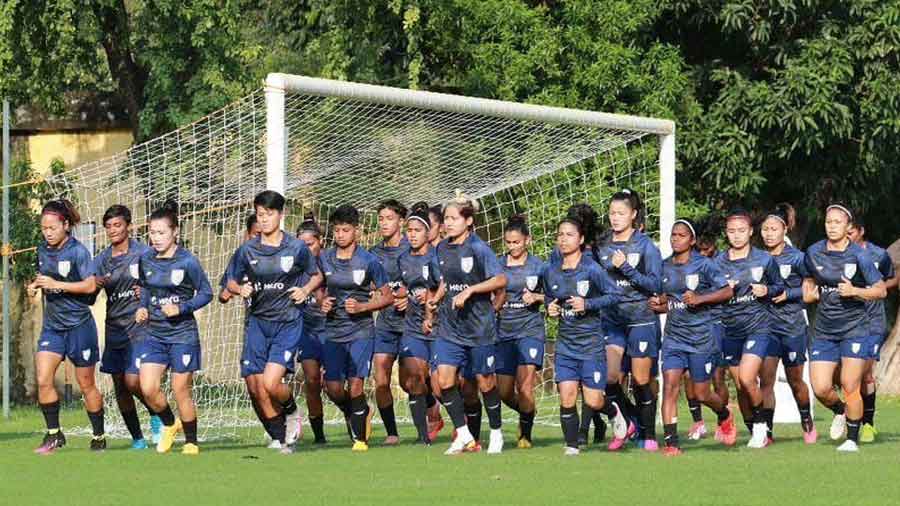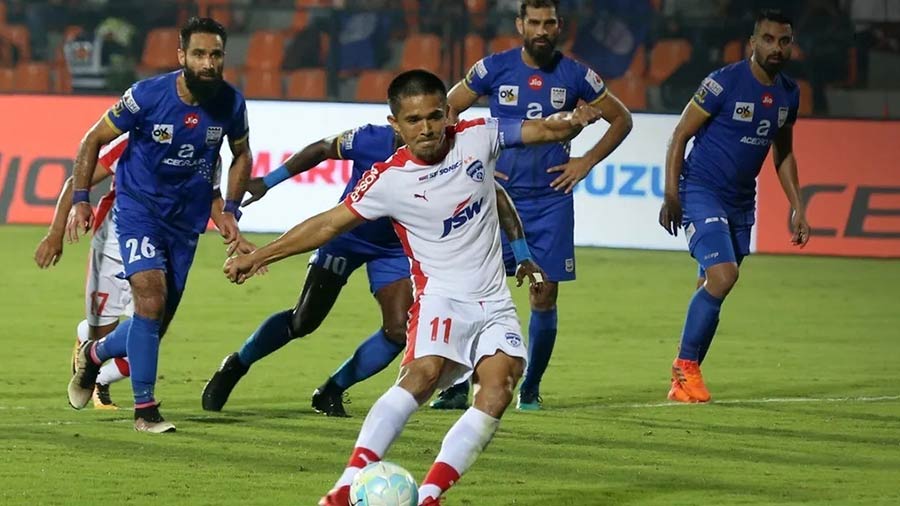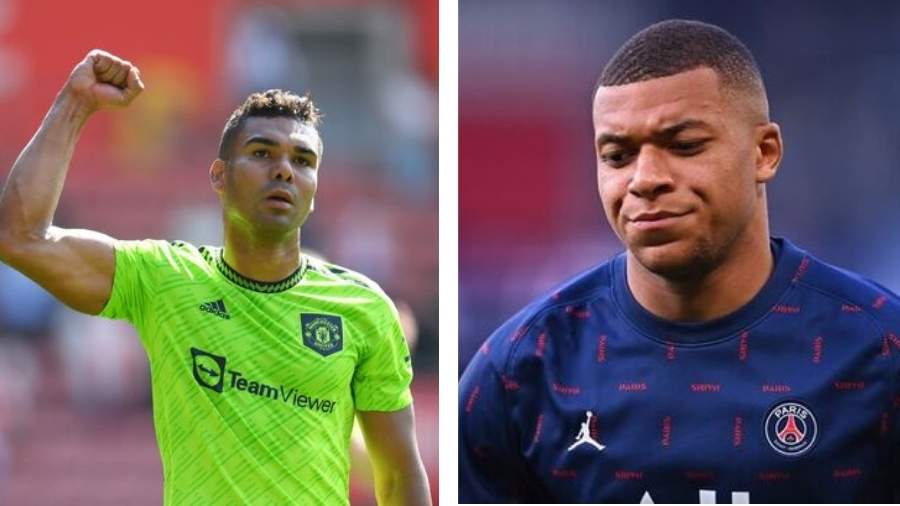How can a nation of more than 1.4 billion people not make it to a single FIFA World Cup, the biggest sporting competition on the planet? Seventy-two years after India voluntarily sidestepped a chance to participate at the World Cup, this question still haunts all those who love the beautiful game in the country.
Competing at a World Cup, of course, needs a system, a plan, a setup that can integrate all stakeholders and provide long-term growth. Awakening the Blue Tigers, published by Om Books International, and co-authored by Neel Shah, a sports management professional and educator, and Gaurav Gala, a veteran broadcast journalist, takes a deep dive into Indian football to analyse its strengths, weaknesses and areas for improvement. The Kolkata launch of the book took place recently, where My Kolkata caught up with the authors and Paul Masefield, football pundit and commentator, to discuss the most important issues in Indian football.
Edited excerpts from the conversation follow.
The history books justify AIFF not sending India to the 1950 FIFA World Cup, but…

(L-R): Neel Shah, Gaurav Gala, Shantanu Ray Chaudhuri (editor-in-chief of Om Books International), and Paul Masefield at the launch of ‘Awakening the Blue Tigers’ in Kolkata
Subham BeheraMy Kolkata: There has long been a misconception that India could have played at the 1950 FIFA World Cup in Brazil but did not because the players were not allowed to play barefoot. Could you tell us the real reason why India did not make it to the tournament?
Neel Shah (Neel): From the research that we did, it was clear that all the Indian players were used to playing with boots, though some of them would choose not to wear boots depending on the conditions. But the main reason why they didn’t go to Brazil was because the AIFF chose to make the 1951 Asian Games (in Delhi) a bigger priority. Field-hockey wasn’t a part of the Games, which made football India’s best hope for a medal in a team sport. At the time, the FIFA World Cup simply wasn’t considered to be as important as it is today.
Gaurav Gala (Gaurav): At that point, the Olympic Games were also considered to be much more important (than the World Cup) from a footballing standpoint. India wanted to do well in the 1952 Helsinki Olympics, and if you look at the history books, we finished fourth in the Olympics, a year on from winning the gold medal in the Asian Games. In a way, it justifies what the AIFF did.
But with the benefit of hindsight, would India’s football fortunes have turned significantly had we managed to play a World Cup sometime between 1950 and 1980, when we produced some of our finest teams? Or are we overestimating the impact of World Cup participation on a team’s growth?
Gaurav: I don’t think we can overestimate the impact of something like the World Cup. As Indians, we’re an aspirational people. We want to do something big on the world stage, and football is no exception. Given its global popularity and reach, football is one of the few sports where you can compete at the international level and genuinely claim to have played against the rest of the world. You’ve got more than 200 countries trying to qualify for the World Cup, which gives an extra meaning to the competition and its name.
Neel: I think the example of the US might be useful in answering this. In 1950, the US competed in the World Cup, even beating England. But they didn’t qualify for another World Cup until 1990. Then the US hosted the World Cup in ’94, played again in ’98 and made it to the quarter-finals in 2002. It normalised the idea that the US can be there on that stage every four years. Coming to India, there’s no denying that some of our best players never had the chance to see how good they were on the world stage because of India not being able to qualify between 1950 and 1986. Even the coaches missed out on a lot of valuable exposure.
Being more consistent in Asia will help India be more consistent at World Cups

Shah, Gala and Masefield all feel that India can make it to the World Cup within the next decade or two
Subham BeheraFrom 2026, the men’s World Cup will expand to include 48 teams. How much of a difference will that make to India’s chances and what is a realistic timeline for India to feature at a World Cup?
Gaurav: Short answer, we can absolutely make it in 2026 and/or 2030. A longer, more pragmatic answer is that a lot of things need to fall into place. There may be more qualification slots from Asia as a result of the overall expansion, but the opportunity extends to all teams in Asia. We need to create the conditions in our country to exploit the additional opportunity. I was talking to Sunil Chhetri recently and he said that we must start by doing consistently well at the Asian level, which will then help us be more consistent in World Cups. That way, we’d rather follow the Japanese rather than the Chinese. Moreover, you can never discount the role of luck, either. When I first started working in Indian football, I used to think that we’d do very well to qualify for a World Cup in my lifetime. Now, I’m quite certain that we will.
Neel: Well, predicting who’s going to qualify for the World Cup is always tricky. Just look at Italy (European champions in 2021, but not going to Qatar)! But more than when exactly we might qualify, we should focus on building an ecosystem that gives us a better chance of qualifying each time. If we get in by a fluke or because we get to host the World Cup (hosts qualify by default), that won’t make me very happy. I’d rather we get in after building a solid base.
Paul Masefield (Paul): It’s about creating a sustainable structure in the long term. I’ve seen the progression of Indian football in the last 10 to 15 years and it’s moving in the right direction. Even at the grassroots levels, football is growing a lot and kids are gravitating towards the game, sometimes even more than cricket. The younger generations are hungrier, fitter and have a better understanding of the game. So, yes, I definitely see India playing at the World Cup. I know it’ll happen in Neel and Gaurav’s lifetimes. I hope it can happen in my lifetime, too!
Empower state associations, more competitive football and better facilities

Changes must happen at all levels of the footballing pyramid in India for the entire ecosystem to thrive
TT archivesIf you had to identify the biggest structural problems with Indian football at present — in terms of administration, management, resource allocation, funding, etc. — what would you highlight and why?
Neel: We need to empower and professionalise our state associations, which I know the AIFF is trying to do. With such a large country, you can’t expect the central federation to do everything. If we can really get to the deepest levels of the states and get the local leagues running, ensure the coaches are given the right resources and that young kids are encouraged to take up the game, you’ll start seeing a lot of positive changes in the overall ecosystem.
Gaurav: Carrying on with Neel’s point, what we need more of are structured competitions at every level of the footballing pyramid. Beyond going to academies — and there are lots of them in India now — you need competitive football, just like we have in cricket.
Paul: I’ve been a part of growing state leagues in Malaysia and it’s imperative for India to do the same. Not just to develop youngsters for football, but also for life. We all know what a great teacher football is. And while you’re growing the game, you must have better facilities. Once you have that, kids and good coaching will follow. That will also allow India to expand its pool of players across the country, getting serious numbers to choose from for the national team.
The entire ecosystem needs to get behind women’s football in India

India’s women were not very far away from making it to next year’s Women’s World Cup, reminds Masefield
AIFFHow do you assess the position of women’s football in India right now?
Neel: There’s just not been enough competitive football for the women. Most of the junior leagues in the country are all for boys or men. What incentive do girls have to keep going up the footballing ladder? We’re slowly starting to see a shift, but things won’t change overnight.
Gaurav: We need a structure and entity working on just women’s football. It’s extremely important to give due care to the women’s game, because the potential is there. A lot of experts believe that our women’s team may make it to the World Cup before the men do. The entire ecosystem needs to get behind the women to make it happen, from the federation to the government to the corporate sector. On this note, the BCCI has just guaranteed equal pay for male and female cricketers. I hope that sets an example for football and other sports to follow, because that will definitely have an impact on female development in sports.
Paul: Let’s not forget that they weren’t that far from qualifying for next year’s women’s World Cup. If it weren’t for the pandemic and some unfortunate circumstances, I believe they’d have qualified. I agree with Gaurav when he says that the women can reach the World Cup before the men, but they need proper backing.
Viewership for ISL games often surpasses that of Premier League matches in India

Sunil Chhetri in action during the ISL
Indian Super LeagueThe debut of the Indian Super League (ISL) in 2014 was seen as a turning point for Indian football. Has ISL lived up to its promise or has it made Indian football more complicated and hierarchical by downgrading the pre-existent I-League?
Neel: If you look at the US model, there was the North American Soccer League (NASL) between 1968 and 1984, with the likes of Pele and Franz Beckenbauer as the stars. Many teams were filling up stadiums every week but the league structure wasn’t sustainable. Then, in 1996, Major League Soccer (MLS) entered the fray. Initially, there were lots of little innovations to the sport to make it more palatable for an American audience, but eventually the league and its structure found its footing. While NASL had helped to develop the football culture in a few markets, MLS gave it the structure it needed to flourish with an effective business model. I don’t see why something similar can’t happen in India with the I-League and the ISL. Also, the ISL is just eight years old. It’s still quite young. I have confidence that over time the league will thrive and find a way to effectively co-exist with the I-league to further the professional football landscape in the country.
Paul: Simply put, the ISL is getting more players playing the game in India. That’s perhaps been the biggest impact. It’s added more layers to the footballing pyramid and given more options for coaches to choose their teams from. Plus, football as an industry can’t stand still, and the ISL is here to keep things moving.
From the perspective of fans, do you think that the increasing popularity of international leagues and teams among Indians, especially the urban youth, gets in the way of the growth of football at home?
Gaurav: No, I don’t think that’s an impediment. I think there’s room for multiple fan allegiances to coexist. Even at tournaments like the World Cup, a lot of us pick several teams to get behind, not just one. What can be an impediment is making Indian football compete for eyeballs in direct face-offs with European football. If Indian domestic football is airing on the same day, at the same time as a Manchester United or a Real Madrid game, then beyond a point you can only get so many Indians to watch the former. Having said that, research shows that the viewership for ISL games often tends to surpass that of Premier League matches in India!

Both Gala and Masefield have opted for England to be the surprise package at the upcoming FIFA World Cup in Qatar
FIFASome rapid fire questions:
Your favourite Maidan football legends.
Neel: Katsumi Yusa
Gaurav: Sunil Chhetri
Paul: Bhaichung Bhutia
Your favourites and surprise packages for this World Cup in Qatar.
Neel: The US and, well, the US! I have to root for the country I grew up in.
Gaurav: France to win it and England to punch above their weight.
Paul: You just stole my thunder, Gaurav! But I’m going with Germany and England.
Your favourite Indian football moment till date.
Neel: Watching the 2008 Federation Cup final between Mohun Bagan and Dempo at a packed Salt Lake Stadium.
Gaurav: First, the first-ever game of the ISL, between Atletico de Kolkata and Mumbai City, in 2014 at the Salt Lake Stadium. Second, the Brazil-England semi-final at the 2017 FIFA U-17 World Cup, which was shifted on three days’ notice from Guwahati to Kolkata and was still played in front of a sold-out stadium.
Paul: Sunil Chhetri’s goal to make India qualify for the 2023 AFC Asian Cup.








